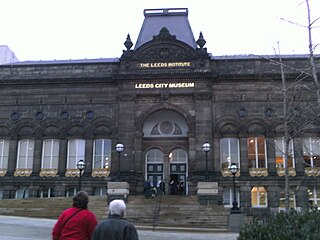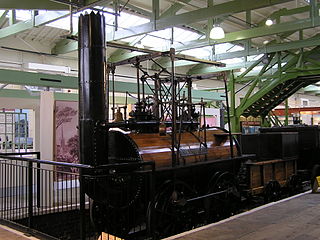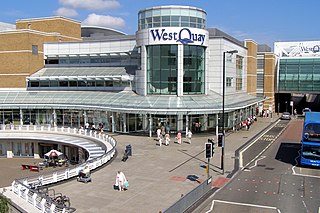Related Research Articles

Darlington is a large market town in County Durham, England. The Borough of Darlington is governed from the town. In 2011, the town had a population of 92,363 and the larger Borough of Darlington‘s population was recorded as 105,564.

Mechanics' institutes, also known as mechanics' institutions, sometimes simply known as institutes, and also called schools of arts, were educational establishments originally formed to provide adult education, particularly in technical subjects, to working men in Victorian-era Britain and its colonies. They were often funded by local industrialists on the grounds that they would ultimately benefit from having more knowledgeable and skilled employees. The mechanics' institutes often included libraries for the adult working class, and were said to provide them with an alternative pastime to gambling and drinking in pubs.

The Lloyd's building is the home of the insurance institution Lloyd's of London. It is located on the former site of East India House in Lime Street, in London's main financial district, the City of London. The building is a leading example of radical Bowellism architecture in which the services for the building, such as ducts and elevators, are located on the exterior to maximise space in the interior.

Shildon is a town and civil parish in County Durham, in England. The population taken at the 2011 Census was 9,976. It is situated 2 miles (3.2 km) southeast of Bishop Auckland, 11 miles (18 km) north of Darlington, 13 miles (21 km) from Durham, 23 miles (37 km) from Sunderland and 30 miles (48 km) from Newcastle upon Tyne.
Edward Pease, a woollen manufacturer from Darlington, England, was the main promoter of the Stockton and Darlington Railway, which opened in 1825. He is sometimes referred to as the "Father of the Railways".

Locomotion No. 1 is an early steam locomotive that was built in 1825 by the pioneering railway engineers George and Robert Stephenson at their manufacturing firm, Robert Stephenson and Company. It became the first steam locomotive to haul a passenger-carrying train on a public railway, the Stockton and Darlington Railway (S&DR).

Westquay is a shopping centre in Southampton, United Kingdom. It has an area of 95,600 m2 (1,029,000 sq ft) of retail and leisure space and contains around 130 shops, including major retailers such as John Lewis and Partners, Marks and Spencer, Zara, Schuh, Waterstone's, Hollister Co., Apple, and others.

The Darlington Arena is a rugby union and football stadium, located in Darlington, County Durham.

Feethams is a cricket and former football grounds in Darlington, England. The cricket ground has hosted Durham CCC matches.

Hopetown Carriage Works, also known as the Stockton and Darlington Railway Carriage Works, was a carriage works of the Stockton and Darlington Railway built in 1853 in Hopetown, near Darlington, County Durham, England.

George Gordon Hoskins FRIBA, was an English architect responsible for the design of several public buildings in the North East of England. His works include many large and important buildings - mansions, banks, hotels, hospitals, libraries, and schools.

Watford Colosseum is an entertainment venue in Watford, Hertfordshire, England. Established in 1938, as the Assembly Rooms for Watford Town Hall, the complex was extended in 2011 with improvements which included new meeting spaces, a new restaurant and new bar facilities.

The Carnegie Library is in Egerton Street, Runcorn, Cheshire, England. It is recorded in the National Heritage List for England as a designated Grade II listed building and "possesses special architectural and historic interest within a national context". It was built in 1906 as an extension to Waterloo House and the existing library with a grant from Andrew Carnegie, and closed in 2012.
Gatherley Castle, sometimes referred to as a modern mansion, was located in the township of Middleton Tyas, North Yorkshire, England.

The Barbican Centre is a performing arts centre in the Barbican Estate of the City of London and the largest of its kind in Europe. The centre hosts classical and contemporary music concerts, theatre performances, film screenings and art exhibitions. It also houses a library, three restaurants, and a conservatory. The Barbican Centre is member of the Global Cultural Districts Network.

University Hospital of North Durham is an acute care hospital built to replace the older Dryburn Hospital on the same site. It is managed by the County Durham and Darlington NHS Foundation Trust.

Darlington Town Hall is a municipal building in Feethams, Darlington, County Durham, England. It is the meeting place of Darlington Borough Council.
St Hilda's Church, Darlington is a Grade II listed former Church of England church on Parkgate, Darlington, County Durham.

Northallerton Town Hall is a municipal building in the High Street, Northallerton, North Yorkshire, England. The structure, which is the meeting place of Northallerton Town Council, is a grade II listed building.

Stokesley Town Hall is a municipal building in the Market Place in Stokesley, North Yorkshire, England. The structure, which accommodates the offices and meeting place of Stokesley Town Council, is a grade II listed building.
References
- 1 2 Bradley, Alan. "The Mechanics Institute, Skinnergate, Darlington". English Heritage. Archived from the original on 12 May 2014. Retrieved 11 May 2014.
- 1 2 Lloyd, Chris (11 March 2013). "Darlington: a hothouse of design". The Northern Echo. Archived from the original on May 13, 2014. Retrieved 11 May 2014.
- 1 2 3 4 5 6 7 8 9 10 Lloyd, Chris (10 March 2014). "HISTORY: School for rude mechanicals". The Northern Echo. Retrieved 11 May 2014.
- ↑ Henderson, Vicki (20 November 2013). "Darlington private snooker club gets the go-ahead after councillors hear that disabled access is not possible at chosen venue". The Northern Echo. Retrieved 11 May 2014.